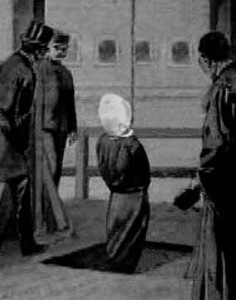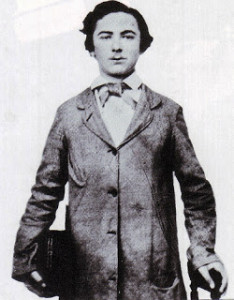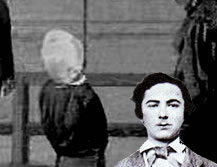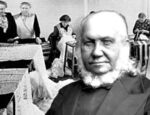Description
 See the execution of Elizabeth Martha Browne, a servant of lowly background and, along with Aeschylus’ Clytemnestra, a model for the heroine of Thomas Hardy’s Tess of the D’Urbervilles (1891). Tess is actually descended from an aristocratic family, but is raised in dire poverty and labours throughout the novel in the hardest jobs the 19th-century rural economy offered: milking cows, harvesting, feeding the threshing machine. Tess is hanged at the end of her novel for stabbing her abusive seducer Alec D’Urberville to death in their bed; Browne was the last woman to be publicly hanged in the county of Dorset in 1856, after killing her drunken husband—as Clytemnestra killed Agamemnon–with an axe.
See the execution of Elizabeth Martha Browne, a servant of lowly background and, along with Aeschylus’ Clytemnestra, a model for the heroine of Thomas Hardy’s Tess of the D’Urbervilles (1891). Tess is actually descended from an aristocratic family, but is raised in dire poverty and labours throughout the novel in the hardest jobs the 19th-century rural economy offered: milking cows, harvesting, feeding the threshing machine. Tess is hanged at the end of her novel for stabbing her abusive seducer Alec D’Urberville to death in their bed; Browne was the last woman to be publicly hanged in the county of Dorset in 1856, after killing her drunken husband—as Clytemnestra killed Agamemnon–with an axe.
Browne’s husband, also a servant, had beaten her with a horse-whip after a fight which started when she found him in bed with his Cassandra. The Dorset County Chronicle reported that Browne described how she retaliated when her husband bent to tie his shoelaces: ‘much enraged, and in an ungovernable passion at being so abused and struck, I seized a hatchet…and struck him several violent blows on the head…’.
 No wonder the young Hardy heard a parallel with Aeschylus’ Clytemnestra. After killing Agamemnon, she reports, ‘I struck him twice. He screamed twice and his limbs went limp. Once he had collapsed I gave him a third and final blow… I don’t think his death was undeserved… he started it, has paid for it and has died violently.’
No wonder the young Hardy heard a parallel with Aeschylus’ Clytemnestra. After killing Agamemnon, she reports, ‘I struck him twice. He screamed twice and his limbs went limp. Once he had collapsed I gave him a third and final blow… I don’t think his death was undeserved… he started it, has paid for it and has died violently.’
At the age of sixteen, Hardy went along with hundreds of other local people to witness Browne’s execution. He was apprentice to the local builder-architect and studying the ancient Greek tragedians with the help of his educated friend, Horace Moule. Hardy stood just beneath the scaffold as Browne struggled at the end of the noose. He later recalled how vivid an impression her death had made on his memory: ‘what a fine figure she showed against the sky as she hung in the misty rain, and how the tight black silk gown set off her shape as she wheeled half-round and back.’




